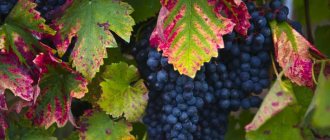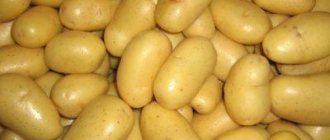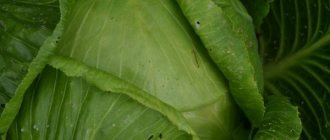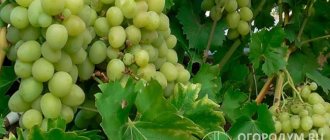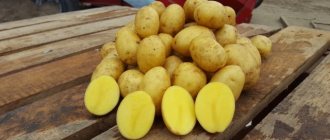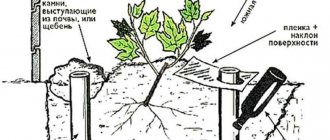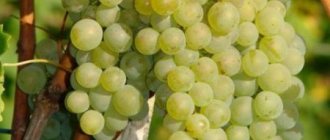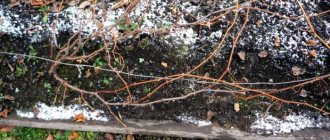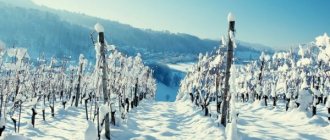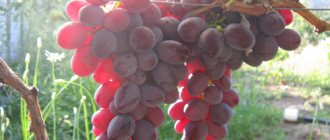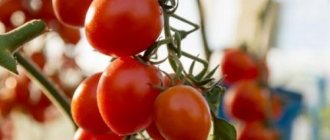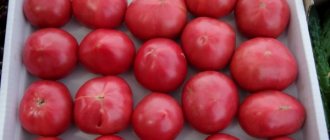Description of the variety
The Pandora strawberry variety has appeared recently.
It is very popular.
Gives a good harvest.
It is a late variety.
Suitable for many regions of the country.
Tolerates cold well.
Additional pollination is required.
The berries are large.
Weight up to 60 grams.
- Strawberry Pandora is a late variety. The plant begins to bear fruit at the moment when other species have finished doing so.
- It has increased frost resistance.
- But also during the cultivation period, Pandora Strawberries do not need to be covered for the winter.
Additional flower pollination can be challenging!
The variety requires additional pollination, which is quite problematic to achieve, since the fruiting period falls at a rather late period. However, many summer residents note that next to Vikoda this variety is complemented and brings great fruit.
Due to the fact that flowering occurs quite late, the fruit bearings are not affected by spring frosts. Pandora strawberries have high immunity to most diseases of the root system.
Productivity per bush
From one average bush you can harvest about 0.5 liters of strawberries per season.
About half a liter of berries is collected from a strawberry bush.
Characteristics of berries
- The berries are quite large.
- The average weight of Pandora's Strawberries is 60 grams .
- The fruits have a round shape.
- Initially, the berries become pink, but during the period of final ripening they acquire a dark red, sometimes burgundy hue.
- Strawberries become juicy and tasty.
- The aroma of the berries is reminiscent of wild strawberries.
Strawberry fruits are round in shape.
The berries are transportable and can withstand transportation over long distances.
Vitamins and minerals
Pandora strawberries contain a huge amount of vitamins.
| Vitamins | Characteristic | Contents per 100 g. (mg.) |
| WITH | Refers to the strongest antioxidant. In case of infectious diseases, it activates the immune system. | 60 |
| A | Able to supply skin and cells with oxygen. Improves the condition of hair, nails and skin. | 0,005 |
| IN 1 | Supports the functioning of the gastrointestinal tract, reduces the risks of heart disease. Improves brain function. | 0,03 |
| AT 2 | Improves vision, as well as the condition of the skin, hair and skin. | 0,05 |
| AT 5 | Participates in the process of breaking down fats and carbohydrates in the body. | 0,3 |
| AT 6 | Able to regulate the proper functioning of the heart. Has a beneficial effect on hair and skin. | 0,06 |
| AT 9 | Necessary for the creation and development of cells in the body. During pregnancy, this vitamin is necessary for the proper development of the fetus. | 0,02 |
| E | It has a positive effect on the reproductive function of both men and women. | 0,5 |
In addition, the fruits contain a large number of minerals and trace elements.
| Minerals | Characteristic | Contents per 100 g. (mg.) |
| Potassium | Improves heart function. Prevents the development of atherosclerotic plaques. | 161 |
| Sodium | Needed to improve the functioning of the body as a whole. The microelement improves blood composition. | 18 |
| Magnesium | Provides prevention against heart diseases, in particular arrhythmias. | 18 |
| Sulfur | Produces collagen synthesis. Improves skin color. | 12 |
| Calcium | Prevents the development of osteoporosis and other diseases associated with the human skeleton. | 40 |
| Iron | Takes direct part in the metabolic process in the body. Needed for normal functioning of the gastrointestinal tract. | 1,2 |
Characteristics of the bush
Pandora strawberries have small bushes, the height, as a rule, does not exceed 20 cm. It is worth noting that this variety is distinguished by a large number of leaves on the bushes, which protects the fruits from overheating in the sun.
Strawberry leaves protect the fruit from sunlight.
Peduncles
The plant produces a large number of flower stalks annually, due to which the yield of Pandora Strawberry remains high . The peduncles are located below the foliage and are quite thin. Often after the fruits ripen, the flower stalks along with the berries lie on the ground.
After the berries ripen, the flower stalks lean against the ground.
Foliage
The leaves of Pandora's Strawberry are slightly wrinkled and have a light green color. Closer to cold weather, the foliage acquires a dark color, and later even brown.
The leaves are slightly wrinkled and light green in color.
Characteristics of Pandora's Malling
The plant is quite tall and abundantly covered with leaves. It is very easy to propagate Pandora, since the bush forms a fairly large number of strong mustaches.
The leaf blades are small in size and bright green in color. Glossy type, shines very well in the sun.
Molling Pandora blooms profusely; the bush forms up to 10 thin peduncles, which cannot hold the berries and lie on the ground.
The berries are quite large, round-conical in shape. At the first picking, the berries have the largest mass, up to 50-60 grams. With subsequent harvests, the weight of the berry drops to 25-30 grams.
The color of the shell of the Pandora fruit at the stage of technical maturity is orange-red. The berries are glossy and sparkle in the sun. At the stage of full ripening, the fruits acquire a dark cherry color.
Pandora fruits have an excellent taste. They are sweet and sour. The harmony between sourness and sweetness is maintained to the maximum.
The pulp of garden strawberries is medium dense, juicy, and the same color as a technically ripe berry. Exudes a pleasant strawberry scent.
The surface of the berry is dotted with small achenes of a yellow-red hue. The berries are planted quite deeply.
As noted earlier, the density of the berry is average, so it cannot be said that it can be stored and transported for a long time. Transportability indicators are within 3.5 points out of 5 possible. Therefore, when growing for commercial purposes, you need to pay attention to local markets or processing, since Pandora will not survive long-term transportation.
Despite the fact that it is a garden strawberry, its pollen is sterile. This is a huge disadvantage, which is why the variety is in such little demand in commercial circles. Pollen sterility indicates that the variety is self-sterile, that is, without a pollinator it will not be possible to obtain a good harvest.
Pandora berries begin to ripen towards the end of June. As for productivity, it is at a fairly high level. From 1 bush you can safely get up to 0.8 kg of berries.
Methods of controlling diseases and pests
The danger for strawberries is represented by fungi, which, when multiplying, cause gray rot, powdery mildew, and various types of spotting. Compliance with the rules of agricultural technology helps reduce the likelihood of activation of pathogenic microorganisms.
If spores appear on the bushes, the affected stems and leaves are cut out, and the plantings are sprayed with fungicides. Processing can be performed only before the formation of flowers and after picking the berries. The Pandora strawberry is suffering from an invasion:
- aphids;
- weevils;
- spider mite.
To cope with pests, insecticides are used in the form of “Aktellika”, “Aktara”, “Bi-58”, “Inta-Vira”. Timely watering, prevention, and fertilizer help increase the hybrid's resistance to parasites and diseases.
Further care
It includes regular watering, fertilizing, removing weeds and mulching, as well as, if necessary, covering plants for the winter.
Watering mode
It is advisable to water Pandora regularly, abundantly, but in small droplets. Newly planted bushes are watered once every three days in the heat. Once their roots are established, weekly watering is sufficient. In wet weather it is not needed at all.
See also
Description and characteristics of strawberries of the Irma variety, nuances of planting and care
Read
Which fertilizer does the variety prefer?
Strawberries of the Pandora variety respond with gratitude to fertilizing with organic matter, but are “indifferent” to nitrogen fertilizers. Organic mixtures are usually applied in early spring, but before transplanting - at any time of the year. Complex mineral fertilizers with potassium, nitrogen, and phosphorus are added to Pandora after harvesting.
Weeding and loosening
To prevent strawberries of any variety from having to “share” beneficial nutrients from the soil with weeds, parasitic greens must be removed in a timely manner. To avoid damage to Pandora's roots, weeding and loosening are carried out after watering or rain regularly throughout the entire growing season of the crop - from spring to autumn.
Mulching strawberries
This procedure serves the following purposes:
- reduce the rate of moisture evaporation from the soil;
- reduce the growth of weeds;
- help keep ripe berries clean in any weather.
Straw and peat mixed with sand are used as natural traditional materials. It is more expensive, but more convenient, to use modern synthetic materials - spunbond, agrofibre.
Treatment for diseases and parasites
If there are signs of fungal damage to strawberry plants, all affected stems, leaves or bushes on Pandora are completely removed, and the plantation is treated with fungicides.
Treatment of plants with any chemical preparations can be carried out only before the formation of flower stalks or after the end of harvesting.
Some gardeners carry out preventive spraying of Pandora with medicinal solutions in stronger dilutions - Aktellik, Aktara, Inta-Vir, Bi-58.
Shelter in winter
In central Russia, and even more so in its southern regions, the Molling Pandora variety does not require winter cover. However, if the plants were planted late or were affected by weather conditions and by the beginning of frost the young bushes did not have time to grow stronger after the formation of buds, it is advisable to cover them.
Among modern materials, lutrasil (agrofibre) is optimal, but the use of hay, healthy dry foliage, sawdust, and spruce branches has also been proven effective.
Strawberry care
To obtain a rich harvest, in addition to proper planting and soil preparation, crop care is required during the flowering and fruiting period.
To get a good harvest, you need care.
Strawberry Pandora cannot be classified as a fastidious crop, but it still needs minimal care.
Watering
Initially, when planting Pandora Strawberries, it is not recommended to water the bushes at the root. This is explained by the fact that water can erode the root and the plant will not take root.
To water transplanted strawberries, use a special watering can, which has a nozzle for fine-drip irrigation.
Strawberries require fine drip watering.
But, despite all the caution, it is necessary to water the bushes with quite a large amount of water. The frequency of the procedure is 1 time every 3 days . After strengthening the roots of the Pandora Strawberry, you can water it once every 7 days . If the weather is damp, the plant does not need watering.
Strawberry fertilizer
After receiving the first harvest, it is necessary to fertilize the soil, since the ripening of the berries takes away all the beneficial substances from the soil. Ammonia fertilizers can be used for this purpose. Feeding should be done in mid-August. If there are no fruits on the bushes, this procedure must be postponed until spring. Fertilizers and fertilizing provide the necessary components to the plant and stimulate fruit growth.
Ammonia fertilizers can be used to fertilize the soil.
Preparing for winter
After the cold snaps, but before the onset of stable frosts, all dried leaves on the strawberry bushes are cut off. The growing point and healthy leaves should remain intact. After pruning, the soil surface is mulched with a layer of peat, straw or sawdust. In regions with little snowy winters, it is recommended to additionally cover strawberries with two layers of non-woven covering material.
If there is insufficient precipitation in the autumn, before the onset of a steady cooling, water-recharging irrigation is carried out. Plants overwinter much better in moist soil. In case of a large number of diseases, preventive treatment with fungicides is additionally carried out before mulching. For example, you can use Bordeaux mixture.
Strawberry Pandora: prevention and diseases
Among the most common diseases of the variety are:
- Spots on foliage (white, brown) . This disease prevents the full development and growth of strawberries. At the same time, the berries do not fill up, but remain small. The disease must be treated by spraying Pandora Strawberries with a soap solution. Such spraying is recommended to be carried out only as the disease appears. For preventive purposes, it is possible to carry out the procedure in late autumn or early spring.
- Powdery mildew . This disease is one of the most dangerous. Initially, the leaves of the plant begin to curl, and a brown tint appears on them. At the next stage of the disease, the stem is affected, and the fruits become covered with plaque, after which they rot. In order to cure the bushes, you need to treat them with a sulfamide solution.
- Gray rot . With this disease, a gray coating appears on the berries. This plaque is fungal in nature. To get rid of the disease, you need to remove all affected fruits, this will prevent further infection. In order to prevent this disease, you can treat the bushes with copper sulfate during the flowering of Pandora Strawberries.
- Strawberry mite . Initially, black dots appear on the leaves, after which the leaf becomes completely black. Spraying with karbofos will relieve strawberries from this disease.
Strawberry varieties often have spots on the foliage.
To get a large harvest of Pandora Strawberries, you need to follow all the recommendations for caring for the crop. Timely feeding and fertilizers can prevent many diseases.
Difficulties in growing and recommendations for gardeners
The main problem for those who do not have other late varieties besides Pandora is its sterility. Therefore, you need to think about which varieties will act as donors in advance.
If, as a result of violations of the rules of agricultural technology or due to prolonged unfavorable weather conditions, strawberries become sick, measures to save them must be taken urgently:
- in case of gray mold disease, destroy the spoiled fruits, and for prevention, spray the plants after the start of flowering with a solution of copper sulfate;
- for leaf spot on Pandora - use fungicides Bayleton, Topaz or similar in effect.
It is rare, but it happens that the taste of Pandora strawberries is very weakly expressed. The reason is usually considered to be the peculiarity of the soils in the region and violations of agricultural cultivation techniques.
Features of the variety
The most significant feature of the variety is the need for additional pollination, which is quite difficult to select.
This difficulty is due to the fact that the Pandora Strawberry blooms quite late. Vikoda strawberries, which are planted next to Pandora, do an excellent job of pollinating.
Strawberries of the Vikoda variety planted nearby will help with pollination of the Pandora strawberry variety.
But it is also worth noting that in wet weather the berries may rot . This is due to the fact that flower stalks with a large number of berries lie on damp soil. For this reason, you can mulch the beds with straw or hay.
Pros and cons of the variety
The undoubted advantages of the Molling Pandora hybrid:
- The late start of fruiting prolongs the possibility of consuming fresh berries.
- High frost resistance makes it possible not to cover the bushes of the plant in winter in most Russian regions.
- Resistant to root diseases and some fungi. The berries are also resistant to rotting - even after several days of rain they remain firm and healthy.
The advantages of Pandora strawberries include its high yield combined with excellent taste, sweetness with a slight sourness.
Disadvantages of a hybrid:
- due to the self-sterility of Pandora and the late appearance of peduncles, it is necessary to think in advance about the possibility of pollination;
- the need to cover the soil with mulch to prevent the development of rot - in wet weather, flower stalks weighed down by an abundant, large harvest bend low to the ground;
- Pandora strawberries have low drought resistance - when there is a lack of moisture, the bushes become smaller and produce few runners.
How to properly care for crops
In order for the English hybrid to please you with a harvest of beautiful and sweet berries, you will have to take care of the strawberries.
Soil and fertilizers
Garden strawberries grow well in light, loose soil, which contains a little sand, and thrive on loam with an acidity of up to 7.
The development of strawberries is accelerated by the addition of mineral complexes, as well as humus or bird droppings diluted in water in a ratio of 1 to 20–25. Organic matter is more often used in the spring and when transplanting bushes to another place.
The Pandora variety responds positively to fertilizing with fertilizers that contain:
- phosphorus;
- magnesium;
- potassium.
Mineral complexes are added after picking the berries. Microelements are necessary for strawberries to form new buds and form roots.
Watering and humidity
In order for garden strawberries to grow, develop, and delight you with a high yield, it is worth installing a drip irrigation system. The roots of the plant are located close to the surface; the stream of water from the hose must be directed carefully.
Water strawberries once a week, and somewhat more often during the flowering period. In cloudy weather there is no need to moisturize. It is better to start the irrigation system early in the morning; during the day the water evaporates quickly.
Relation to temperature
Summer residents noticed that the Pandora variety, grown in hot climates, ripens small berries. Spots from sunburn often appear on fruits. In mid-latitudes in humid weather, strawberry shoots develop faster, which is not surprising, since the homeland of the hybrid variety is England, where it is damp and cool.
Loosening and weeding
The beds on which strawberries are planted should not be allowed to become overgrown with weeds. They need to be pulled out by the roots and fought from early spring until autumn. The soil is loosened after irrigation or rain.
Mulching
To reduce moisture evaporation, the soil under the bushes is covered with straw or peat mixed with sand. In recent years, gardeners have been using agrofibre or spandbond for mulching instead of organic matter. When using such materials, the berries do not touch the ground, do not get dirty on the sand, and ripen faster.
Reviews
Reviews from gardeners always contain a lot of useful information. Let's find out what they say about the Malling Pandora variety.
Alexandra Pavlovna
Yes, at the dacha I laid out a 3x5 m bed for Pandora strawberries. The variety is not bad, but rot appears on the berries in damp summer. The fruits are large and tasty. I try to treat it with a fungicide once every season in early spring. I use only a solution of chicken manure as a fertilizer.
Marina
I read a lot about the Pandora variety and decided to get one for myself. The first year the harvest did not bring much delight. There were few berries grown and almost all were small. The next season, strawberries made me happy. Since the fall, I have fed it well with complex fertilizer and humus. The berries are tasty, juicy and sweet. Sour fruits on those bushes that grow in the shade.
Characteristics of the variety
Radish Sora - description
Strawberry Moling Pandora has small compact bushes. Each grows up to 20 cm. To protect against overheating in the sun, the plant has a large number of leaves. They are wrinkled and light green in color; when cold weather sets in, the color changes to darker or even brown.
Thin flower stalks are located under the foliage. After the berries ripen, they fall to the ground. The fruits are large in size, weighing on average 30-60 grams. The parameters of the berry directly depend on the conditions of its cultivation.
The fruits have a round shape without the usual elongated tip. The bright red flesh has a dense texture. Tiny seeds are located in small dimples on the skin. Varietal strawberries ripen late. The berries are harvested from late July to early September. They are distinguished by the richness of their juice, although this feature does not interfere with transporting the fruits over long distances.
Pandora strawberry fruits
This species is also distinguished by its excellent taste and pleasant aroma of wild strawberries. The sweet berry has a slight sourness. The hybrid does not belong to the remontant varieties, that is, this plant does not bloom again. Despite this, the variety is distinguished by an abundant harvest. Each bush is capable of producing up to 500 grams of berries.
Important! The presentation of strawberries is well preserved. The variety is suitable for cultivation for commercial purposes.
Strawberries of the Pandora variety, the description of which is given above, suggests that the hybrid can be used for different needs. The berry will be good for making jam, compotes and juices, as well as for fresh consumption. Decorating desserts with these large strawberries always looks amazing.
Description of strawberries
The Moling Pandora hybrid was obtained by crossing the Ananassa garden strawberry with the Fragia variety. Low bushes are densely covered with shiny leaves. Round berries are laid on thin peduncles, which when ripe acquire:
- cherry color;
- forest aroma;
- weight up to 60 g.
The surface of the fruit, slightly flattened on the sides, is covered with small seeds. The juicy pulp of garden strawberries delights with a sweet taste with a barely noticeable sourness. During transportation, strawberries produced in England do not become deformed and do not release juice.
Characteristics of Pandora
The description of the variety states that the berries ripen in July; from one bush, 300 to 400 g of garden strawberries are picked. The hybrid of English origin tolerates frosts well and even in temperate climates does not need to be covered for the winter. Pandora is valued for its resistance to bacterial infection. Strawberries rarely suffer:
- from powdery mildew;
- verticillium;
- brown spot.
The variety is affected by rot if the weather is damp for a long time. The bushes bloom when the frosts have already subsided; the ovary does not fall off from the cold. Pandora is not a remontant variety and is harvested only once per season. In hot weather, the berries of the hybrid become smaller, and the plant produces few runners.
Diseases and pests
Like any berry crop, Pandora is susceptible to attack by harmful insects and infection with fungal diseases.
Common diseases.
- White and brown spots on leaves. This disease stops the full development and growth of garden strawberries. The berries cannot fill up and form a juicy and dense pulp, but remain small. The antidote will be a soap solution that needs to be sprayed on the foliage. Carry out the procedure until the stains are completely removed. For prevention, you can repeat it in late autumn or early spring.
- Powdery mildew. A very dangerous disease for berry crops. The first symptoms are curling and darkening of the leaves. Then the stem is damaged. The fruits darken and the process of rotting begins. A solution of selfamide will save the bush from the disease.
- Gray rot. The fruits are covered with a gray coating, which is a fungal infection. As soon as you notice affected fruits, remove them to prevent the spread of infection. Copper sulfate will be a preventive remedy.
- Strawberry mite. The leaf becomes covered with black dots and subsequently turns completely black. Karbofos will save you from illness.
History of creation
Molling Pandora was bred by breeders D. Simpson and M. Blanke in 1988-1989 as a result of crossing the varieties (Von Humboldt x Redstar) x Merton Dawn. The work was carried out as part of a program for breeding new varieties of strawberries at the East Malling Research Station. It is the largest fruit research institute, located near the village of East Malling in Kent, UK. This is a truly legendary station, which has become the author of numerous generally recognized “masterpieces” among berry crops. It has also released many interesting new products in recent years. She herself is worthy of a separate article, but more on that next time.
Recommendations for cultivation
- Pandora strawberries are planted on cultivated, well-fertilized, loose soils. Planting is done in early spring or late autumn. If the seedlings have buried roots, then they can be planted in the summer.
- The place for planting strawberries should be well-lit, dry, without drafts or cold winds.
- The soil is suitable with an admixture of sand and clay, with a neutral acidity level. On the eve of planting, the soil should be well fertilized with organic matter and minerals.
- Water strawberries in hot weather 2-3 times a week, and in cloudy weather - once a week. Watering is done early in the morning from a watering can. It is possible to use the drip irrigation method. It is important not to overwater or overdry the plantings.
- Since ripening strawberries literally lie on the ground, a layer of mulch in the form of straw or sawdust is laid under the bushes. This prevents the berries from rotting.
- The most effective feedings are ammonium nitrate, bird droppings or manure diluted with water. Do not allow a solution of organic fertilizers to come into contact with strawberry leaves, as this may cause them to burn.
- Strawberry bushes must be weeded regularly, after which the soil in the root circle should be loosened shallowly. It is recommended to tear off excess leaves. This allows the bush to save nutrients, which are used for fruit development.
- Pandora strawberries can be grown in one place for 4 years, then replanting is necessary, otherwise the berries begin to shrink and degenerate.
Agricultural technology
Seedlings for planting
Strawberry Moscow Delicacy - variety description
The variety is easy to grow on site. But all efforts will be in vain if a bad seedling is chosen for planting. When purchasing a plant, you should pay special attention to its appearance.
If the roots of the bush are damaged, then there is no need to buy it. Such a plant will not take root in a new place. Spots on the leaves indicate that the bush is not healthy. Most likely it is affected by a fungus. An ideal seedling has a whole, not dried out root system that looks like a large brown lump.
Seedling
The number of monochromatic dense leaves on it does not exceed 3-4 pieces. Excess greenery on a plant will slow down its growth because it requires more moisture. If the seedling has no leaves at all, then this indicates its weakness. Such a plant will grow very slowly.
Preference is given to local nurseries or nurseries. This way you can be sure that the right variety was purchased. The plant can be purchased from local gardeners, but only if you are sure that their seedlings will not introduce diseases or pests into the soil.
Landing Features
When starting work, a certain algorithm of actions is performed.
Planting strawberries
It is simple and consists of the following steps:
- Choosing a landing site. It should be sunny, without drafts. Choose south-eastern areas in your garden. The groundwater level does not exceed 1 meter, otherwise the roots of the seedling will rot due to high humidity;
- Soil preparation. Before planting, the soil is dug up and leveled. The variety does not like weeds. After this, fertilizers are applied. Organic substances are used as such: compost or manure. Sand and clay are diluted in water. To do this, they are taken in equal quantities. The result should be a slurry to which organic matter is added in a ratio of 20:1. The soil can also be fertilized with nitrogen;
- Planting seedlings. To move the bush to a new permanent place, use a mulching film or a straw “mattress”. Strawberries are not planted in open ground. If film is used, it is stretched over the entire area. The “mattress” is formed by laying straw on the ground after digging it up and applying fertilizer. Then holes are made in the coating for seedlings. The roots of the plant should be located in the upper layers;
- Watering the seedling.
Important! The hybrid requires pollination. At such times, other varieties of strawberries do not bloom, so strawberries are grown next to the plantings.
Cultivation care
Strawberries love water. During the fruiting period, watering is carried out once every 3 days. The roots of the plant are located in the upper layers of the soil, so as not to damage them, drip irrigation is used. You can also water with a garden watering can with a fine sieve.
During the fruiting period, the soil must be fed with potassium and phosphorus. Ammonia fertilizers are well suited for these purposes. The solution with useful substances should not get on the foliage, otherwise the plant will receive a chemical burn. All manipulations with the plant (watering and fertilizing) should be performed early in the morning or after sunset, when the foliage is not exposed to sunlight.
Strawberry care
In addition, do not forget that strawberries do not like weeds. They must be removed periodically. You can only weed the paths between the rows so as not to damage the roots of the seedling.
In central Russia, before the onset of cold weather, bushes are covered with mulch or straw insulation so that frost does not destroy the roots. In the south, strawberries can survive the winter without additional protection.
Important! Any strawberry variety bears fruit in one place for a maximum of 4 years. After this, the plant should be transplanted to a new location.
Features of growing and caring for the variety
Novice gardeners are often interested in the question of Pandora strawberries, how to plant and care for the crop. An unpretentious variety can be grown by a person with little experience in gardening. It is important to follow the usual rules of care: watering, fertilizing, pest control. However, first you need to plant the seedlings correctly.
Preparing seedlings
In order for Molling Pandora strawberries to produce a good harvest, you must initially select productive seedlings. During the purchase, the appearance of each plant is examined. The root system should look like a large clump of light brown color. It is better not to take seedlings with mechanical damage to the foliage or roots.
Important! Avoid purchasing Pandora strawberry seedlings with pronounced spots on the leaves or damaged roots. These may be traces of bacterial infection.
Video: Molling Pandora - a variety from England
Video: Molling Pandora late variety of strawberry
A seedling with three leaves is considered high-quality planting material. A smaller amount of foliage confirms the weakness of the plant, and a lot of excess green mass will draw nutrients, which will affect the slow growth of the bush.
To be sure that it is Pandora strawberries that you purchased, you should contact a nursery or trusted sellers for seedlings. It is optimal to use the first option. In nurseries, strawberry seedlings are treated for pests. This is a guarantee that the purchased seedlings will not introduce disease into the garden.
Site selection and soil preparation
Continuing the review of Moling Pandora strawberries, descriptions of the variety, photos, reviews, we will dwell on the rules for choosing a planting site. The bed is laid out in a sunny open area, preferably on the southwest side. It is good if the area is ventilated, but without drafts. The maximum permissible location of groundwater to the surface of the earth is 1 m. Otherwise, frequent flooding will cause rotting of the roots of Pandora strawberries.
Before planting seedlings of any variety of strawberry, soil fertilizer is required. For the Pandora variety, this is requirement No. 1. The bed is prepared at least three weeks before planting the seedlings. The earth is dug up to a depth of 30 cm with the addition of manure, humus or compost.
Feeding
The Pandora variety loves clean, weed-free beds, moderately moist soil with admixtures of clay and sand. The optimal acidity ranges from 6.5 to 7.0. Additionally, annual feeding is required. Fruiting exhausts the plant, the berries draw out many useful substances. Organic and mineral fertilizers help restore strength.
From organic matter, bird droppings, manure or compost are usually used, but not in their pure form. The mass is infused in water, then a solution is prepared from the resulting slurry. Add 1 part organic matter to 20 parts water. The resulting liquid is poured over Pandora strawberries at the root. Dry organic matter is usually added in the spring or when planting seedlings in a new place.
Attention! It is unacceptable for the organic solution to get on the foliage to avoid burning the leaf blade.
From mineral fertilizers, at the initial stage in the spring, Pandora is fed with nitrogen. After harvesting, potassium and phosphorus are added. During this period, strawberries are in great need of minerals, as they are depleted of berries. When pouring fruits, mineral complexes are in demand. At the beginning of fruiting, nitrogen is excluded from Pandora’s diet, otherwise the bushes will become fatty and the yield will decrease.
Watering plants
The Pandora strawberry variety does not always tolerate sprinkling well. For watering, it is better to use a drip system, especially during flowering. Sprinkling is also necessary, but in early spring and during the ovary period.
The root system of Pandora strawberries grows in the upper layers of the soil. There is no need to flood the bed too much. Enough for the soil to get wet without puddles accumulating in the holes. You cannot create streams of water on the rows so that the roots are not washed out.
During drought, water the Pandora strawberry variety every 2-3 days. In cloudy weather, the number of waterings is reduced to once a week.
Important! Constant dampness under strawberry bushes causes fungal diseases, and the Pandora variety is sensitive to them.
Video: Strawberry Pandora late variety. surprises
Video: I was pleased with the FIRST strawberry harvest. Moling Pandora and Polka - who is better.
It is better to water the strawberry plantation early in the morning. Before sunrise, the plants will have time to absorb moisture. In the evening, watering is carried out at sunset, when the foliage moves away a little from the heat.
Preparing for winter
The Pandora variety is heat-loving and easier to grow in the southern regions. However, heat has a bad effect on the development of bushes. The shoots form slowly, the berries bake under the sun, losing their taste and presentation.
The variety develops to its full potential in cool climates with moderate humidity. However, harsh winters are detrimental to the plant. Early cold weather is especially terrible. The long process of bud formation delays the onset of the resting phase. To prevent the bushes from freezing, strawberries are covered with straw mats or other insulation.
Advice! If you want to grow the Pandora variety in a cold region, you should first plant up to a dozen bushes as a test and watch how they overwinter.
Reproduction methods
To plant the Pandora strawberry variety on your plot, buy seedlings or seeds. If the crop is already growing in the garden, it is propagated by means of a mustache or by dividing the bush.
The seed propagation method involves growing seedlings. Boxes, glasses or flower pots are prepared for sowing. A drainage layer of stones is poured onto the bottom, and fertile soil mixed with sand and humus is placed on top.
Pandora strawberry seeds are simply scattered on top, lightly pressing into the soil with your finger. The crops are covered with film until shoots emerge. After the sprouts peck, the cover is removed. The seedlings are germinated until two full leaves appear, after which they are planted in separate cups. Before planting in the garden, seedlings are hardened off outdoors.
When the Pandora variety is already growing on the site, you don’t need to go anywhere to get seedlings. Whiskers are used for reproduction. After releasing the side shoot, the area near the formation of the foliage bush is covered with moist soil and watered frequently. Over time, the mustache will take root. The finished seedling is dug up for transplantation, cutting off the shoot from the mother bush.
The third method of propagation is dividing the bush into parts. The method is aggressive. The bushes take a long time to take root, but if divided incorrectly they can die. An adult plant is used for propagation. The bush is divided into two or three parts with a sharp knife. The process occurs in the fall after fruiting. After dividing, each seedling should have at least three leaves and one long root. The cut seedlings are immediately planted in a new place, pouring plenty of water.
Attention! In one place, the Pandora strawberry will give birth for a maximum of 4 years. After this time, a transplant is required.
Fruit
- Pandora berries are enlarged, round, blunt-conical in configuration, without the characteristic pointed nose.
- The weight of the berry is about 50-60 g, and the diameter reaches 6 cm.
- When fully ripe, the strawberry color acquires a deep cherry hue.
- The taste of the berries is sweet and sour, dessert.
- The pulp has a dense consistency, quite juicy, and a coral color.
- The berries exude a delicious strawberry aroma.
- The seeds are medium size, yellow in color, planted deep in the pulp.
- The sepals are slightly attached to the berry itself, so the stalk is difficult to tear off.
- The strawberry skin is of medium strength, so the shelf life and transportability of the berries leave much to be desired.
Distinctive features and characteristics
The foliage of the Molling Pandora strawberry has an original, slightly wrinkled surface. The color is light green, with a slight characteristic shine. The berries weigh 40-60 g, round, slightly cone-shaped. When fully ripe, the color on the outside is dark cherry.
Dimensions and appearance of the bush
Pandora strawberry bushes are sloping, up to 20 cm high, heavily leafy, accumulating a large amount of green mass, but compact. The leaf blades are located above the thin peduncles. The light green color of the foliage turns to dark green and then brown as cool autumn approaches.
The plant produces an average number of tendrils.
Flowering and pollinators
The Pandora strawberry variety produces a large number of flower stalks, up to a dozen in the first year, but it is self-sterile.
It cannot be grown without a pollen donor neighbor. Pollinators use strawberry plants with a similar flowering period. Strawberry varieties Florence, Vikoda, Malvina, Maxim, remontant Murano, Mariget are usually chosen as pollen donors.
Ripening time and yield per bush
Fruiting of Malling Pandora approximately begins in the second ten days of July. In the southern regions, the berries turn red 2 weeks earlier.
See also
Description of strawberries of the Chamora Turusi variety, rules of care and cultivation
Read
On average, 400 g of fruits are harvested from one bush, but provided that high-quality seedlings are used and all agricultural technology requirements are met, the yield from one plant will be 700-800 g. In the future, every year the yield of Pandora increases, but the sweetness of the berries decreases.
Composition and taste of fruits
Sweet with sourness, dessert, the taste of the fruit is reminiscent of wild strawberries. The berries are fragrant. Overripe fruits are the most delicious, but their shelf life and transportability decrease.
Pandora strawberry fruits are rich in vitamin C. About 60 mg per 100 g. In addition, they contain vitamins A, E, a wide vitamin B complex, various minerals and trace elements - potassium, calcium, magnesium, iron, sulfur, sodium.
Scope of application of berries
Due to the fairly high density of the fruit and the keeping quality above average, the Molling Pandora strawberry variety has universal use:
- fresh;
- for canning;
- for decorating baked goods and confectionery products.
Susceptibility to diseases and pests
The Pandora variety is highly resistant to powdery mildew and moderately resistant to Fusarium wilt. However, other diseases that usually affect strawberry plantations are poorly resisted.
Prolonged wet weather combined with errors in care can provoke:
- gray rot - manifested by the formation of fluffy gray plaque on the fruit in spots;
- leaf spot, noticeable by characteristic brown or white spots on the leaf blades.
Of the harmful insects, aphids most often occupy bushes of the Pandora variety. Spider mites attack the plant very rarely during prolonged heat and dry air and soil.
Frost and drought resistance
A plant that is completely ready for wintering can tolerate short-term frosts down to 20-22 °C without damage. If, due to weather conditions, the formation of buds is delayed and the process of preparation for the dormant period lasts until frost, many gardeners practice covering the bushes to be on the safe side.
In dry weather, Pandora plants become smaller in size and the fruits wither.
Disease Control
Most strawberry diseases occur due to non-compliance with agricultural practices. The most common of them are discussed in detail below.
Gray rot
Massive spread of gray rot is observed with the onset of warm and humid weather. Heavily dense plantations suffer especially from it. If left untreated, up to 90% of the crop can die. The main way gray mold spreads is through infected plant debris and fruits. Their regular collection is an excellent prevention.
Powdery mildew
A widespread fungal disease. Massive outbreaks of powdery mildew occur after rainy, cool weather. First, spots with a white coating resembling flour appear on the surface of the leaf plates. With further progression of the disease, necrosis develops in their place. As a result, the infected parts die.
Powdery mildew is very difficult to cure. The fight against it must be comprehensive. Plantations where outbreaks of powdery mildew were observed in the previous season are treated with copper-containing fungicides in early spring. Spraying is carried out twice with an interval of 10 days. The next treatment is carried out after flowering has ended. The last one is in preparation for winter. Spores of the powdery mildew fungus overwinter well in plant debris, so they must be destroyed in a timely manner.
a brief description of
Advantages of the variety
- high productivity;
- large fruit;
- excellent taste, high sugar content even during rainy periods;
- high resistance to ticks;
- drought and frost resistance;
- a large number of whiskers for reproduction;
- late fruiting periods (in Central Russia, the second half of July to mid-August), when most varieties have already bear fruit.
No particular shortcomings have been identified in the variety; the only thing worth mentioning is its low resistance to spotting and other fungal diseases.
Spotting appears mainly on bushes suffering from insufficient watering, in the 2-3rd year of the plant’s life.
Main characteristics
Pandora strawberry bushes are medium in size, the height does not exceed 25 cm. There is a sufficient amount of foliage on the strawberry, thanks to which the berry is reliably protected from direct sunlight during hot summer periods. The foliage is medium in size and bright green in color. The surface of the variety has a characteristic shine, as well as the presence of slight wrinkles. The barnacle formation is average, which does not allow them to be used for reproduction. However, it makes the process of caring for the variety easier.
The main flowering period of the variety is June. At this time, a large number of peduncles are formed on Pandora bushes, which are located below the foliage level. The fruits of the Pandora strawberry variety are large, reaching 60 grams or more. The berries have a regular oval shape, a rich, dark red, sometimes burgundy color. Reviews from gardeners say that the berry has a sweet and rich taste, as well as an aroma reminiscent of young strawberries. The dense pulp of the berry makes it easy to transport over long distances.
Productivity
Pandora is a type of garden strawberry that bears fruit once during the entire summer season. Despite this nuance, crop yield indicators remain at fairly high levels for several years. For example, at one time in the summer, gardeners can harvest up to 500 grams of harvest from just one Pandora strawberry bush.
The importance of pollination
One of the disadvantages of the variety in question is its self-sterility. To get a truly worthwhile harvest, the use of so-called pollinators will be required. Moreover, their flowering period should coincide with the Pandora strawberry variety. This is the difficulty due to the late ripening period. The Vikoda strawberry is considered the most optimal donor for Pandora.
Advantages and disadvantages
Despite certain difficulties in the growing process, Pandora has a number of significant advantages over other berry varieties, among which the following stand out:
- thanks to the late fruiting period, you can get a strawberry harvest at a time when other types of berries no longer bear fruit;
- high level of commercial characteristics of fruits;
- high crop productivity;
- the fruits are large and tolerate frost quite well;
- The variety also has a good resistance to powdery mildew.
The Pandora variety also has disadvantages, for example, the need to select a pollinator. Beginners may not be able to solve this issue. Pandora also does not tolerate drought well. Gardeners also need to remember the need to mulch the beds, preferably with agrofibre. Such measures are necessary due to the fact that the flower stalks are located too low to the ground and can touch the soil when the fruit appears.
Subtleties of growing a plant
To harvest a good harvest of large berries, Pandora strawberries need to be planted in fertile soil and follow the rules of agricultural technology.
Time and place
The hybrid variety does not tolerate drafts, is demanding on lighting, and feels comfortable in the sun. If water comes closer than a meter to the surface, the roots of the plant may die. A place for Pandora strawberries should be chosen on a small hill in the southwestern part of a summer cottage or suburban area. Strawberry bushes are planted in spring, summer or autumn. The soil is dug up in advance, leveled, freed from weeds, and organic matter is added.
Seedlings for planting
When buying strawberry bushes to grow in the country or in the yard, you need to carefully look at how they look and whether they have healthy roots. It is better to purchase planting material not on the market, but in a nursery, where the Pandora hybrid will not be confused with another variety.
Bushes with 3 leaves that are free of spots, stripes and creases are well accepted.
Landing Features
Strawberries are not placed in the place where peppers, tomatoes, potatoes, pumpkins and zucchini grew last season. The Pandora variety, like these crops, is affected by root rot. The best predecessors for strawberries are green manure. A month before planting, the soil on the site is dug up and the following is added:
- compost or manure;
- superphosphate;
- potassium salt.
Fertilizers improve the structure of the soil and make it looser. In the first year, it is preferable to place strawberries according to a single-line scheme. Bushes are planted every 25 or 30 cm, a little less than a meter is left between rows, and the free space is filled with rooted rosettes of mustaches. Before the procedure, the plant is dipped in a solution of potassium permanganate and washed with water:
- Dig holes and form a small mound at the bottom.
- Place the bush, straightening the roots.
- The bud is left above the surface of the earth.
- The hole is filled with soil, compacted and irrigated with warm water, and covered with mulch.
To prevent Pandora from being affected by gray mold, you should not thicken the plantings or apply excessive amounts of fertilizers that contain nitrogen.
If there are strawberry mites in the area, the leaves of the plants are cut off.
Landing rules
The technology for planting the Pandora variety, as well as the process of preparing beds, is similar to working with other varieties of strawberries.
Deadlines
Pandora is sensitive to the timing of planting: in order for it to successfully bear fruit in the first year, it is advisable to plant it in August-early September. Although seedlings are planted in both spring and autumn, depending on the gardener’s workload:
- In the spring, this is done after the snow has melted - the soil should warm up, but still be filled with moisture.
- In autumn - in the third ten days of August or early September. In this case, the seedlings will have time to take root before frost.
Young shoots - mustaches - are transplanted at the end of July and August.
Selecting a site and preparing beds for strawberries
When choosing a site for planting strawberries, Malling Pandora takes into account the following factors:
- plants will be comfortable in a well-lit, sunny space without drafts;
- It is advisable to arrange it on a hill so that groundwater does not come closer than a meter to the roots of the bushes.
The soil is dug up in advance, in the fall, and filled with organic matter. The optimal soil for growing strawberries of any variety is light, with a small addition of clay and sand, and neutral acidity.
Preparing seedlings
Important factors influencing the growth of seedlings and the volume of the future harvest:
- healthy root system;
- trunk, lower part of shoots and leaves - without visible damage, stains, rot;
- in size - it is better to purchase medium-sized plants; seedlings several years old can have too thick stems.
Immediately before planting, the roots of Pandora seedlings are kept for about half an hour in a weak pink solution of potassium permanganate to destroy harmful flora on them.
Stages of the planting process
Rows are marked at a distance of 50 cm, in which holes are made every 30-40 cm with a small mound at the bottom. A seedling of the Molling Pandora variety is placed on it, straightening the roots, and sprinkled with earth so as not to cover the growing point with it, but to leave it on the surface.
Reproduction of the variety
Gardeners who liked Pandora rarely use seeds to propagate strawberries. The seed must be hardened for two weeks at 2 °C in a wet cloth and cotton wool, periodically moistened with water. In February, the substrate is poured into containers or cups and the seeds are laid out, slightly deepened into the soil with a match, covered with film and left in a well-lit place. After a while, the seedlings sprout, and when three leaves appear, the bushes dive into a new container. Grown strawberries are moved to the garden bed no earlier than the end of April.
It is much easier to propagate the variety by lateral shoots. The tendrils that the plant produces are sprinkled with earth. When they take root, which usually happens already in July, they are planted in the garden.
Mature plants from which many berries have been collected are divided into several parts so that each contains up to 3 leaves and an elongated root. In the fall, they dig holes and plant one bush at a time.
Sources used:
- https://frukti-yagodi.ru/opisanie-sorta-klubniki-pandora/
- https://dachamechty.ru/klubnika/pandora.html
- https://sort-klubnika.ru/sorta/klubnika-molling-pandora-odin-iz-samyh-pozdnih-sortov
- https://eda-land.ru/klubnika/sorta/pandora/
- https://7ogorod.ru/plodovye-kusty/klubnika-pandora.html
- https://sortoved.ru/klubnika-zemlyanika/sort-klubniki-pandora-molling-pandora.html
- https://sornyakov.net/berries/klubnika-pandora.html
